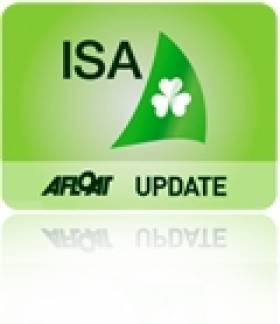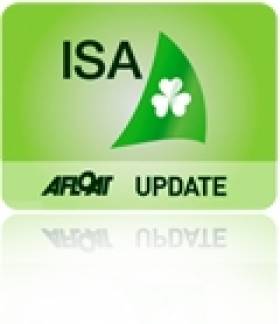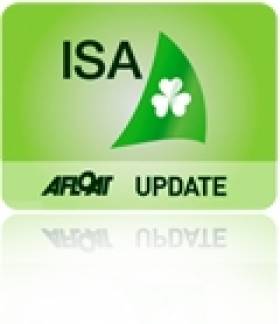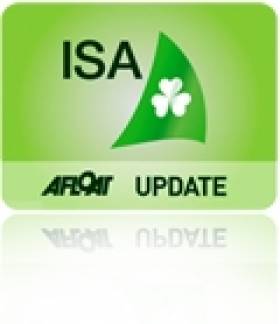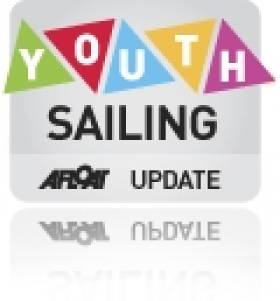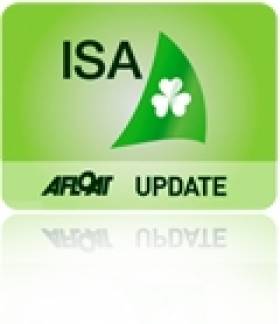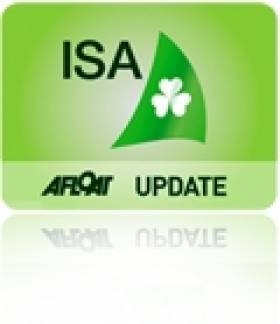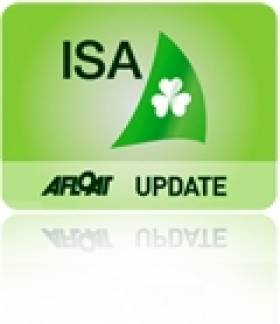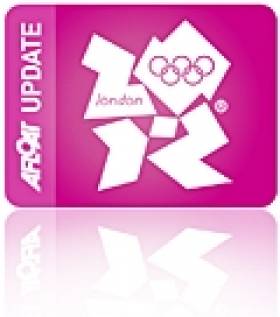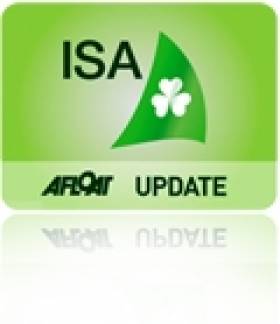Displaying items by tag: ISA
ISA AGM: Dinghy Sailor's Proposal Gains Support
#dinghy – Dinghy sailors are blowing the bugle for change at tomorrow's Irish Sailing Association (ISA) agm with some of the country's top regatta organisers, club commodores, champions and racers joining in an online debate in advance of a motion that has been tabled for discussion at 4.30pm at the Royal Marine Hotel in Dun Laoghaire, Co. Dublin.
This morning the organiser of last year's successful ISAF Youth world Championships in Dun Laoghaire, Brian Craig urges the ISA to build trust with its clubs and classes.
'it should direct it energies at the clubs rather than trying to justify/communicate its existence to the members of the clubs – otherwise it becomes, as Gerry Byrne suggests [see comments], a glorified club rather than a national authority' says Craig.
The dinghy decline subject is also the focus of today's Irish Times Sailing Column by David O'Brien and yesterday's Evening Echo Column by Tom MacSweeney.
ISA Chief Executive Harry Hermon told Afloat.ie 'This is a really useful debate and is welcomed'.
Brian Craig's comments join former association president Roger Bannon and many others in questioning the current dinghy policy which GP14 sailor Norman Lee, who proposed the motion, says is killing off senior dinghy sailing.
'I want a full shake-up. Lets take the focus off the Olympics and have a root and branch reappraisal of sail training' says Lee.
Craig tells the ISA they need to 'Look after the basics' and asks why 'if key key stakeholders are feeling neglected is the organisation expanding into other areas of activity some of which are encroaching on or eroding the activities of their own clubs/classes?'
Craig continues – 'This doesn't build trust and working relationships. It should direct it energies at the CLUBS rather than trying to justify/communicate its existence to the members of the clubs'.
Lee blames an 'over-emphasis of the training of selected juveniles by the creation of elite squads of possible future Olympians'
The champion dinghy sailor says current policy is 'without proper regard to the interests of those failing (for whatever reasons) to meet that standard or who are not able or cannot afford to give the time or family/financial commitment and this discourages people who are lost to the sport'.
Also supporting the motion, the GP14 fleet will ask if the elite squad system has chased the club sailor away? The Fireball class says the current structure is too “youth orientated and fails to develop the ISA’s own slogan of sailing as a ‘sport for life’”.
Anther sailor with a unique insight into this is seasoned dinghy and one design helmsman is the Dublin Bay sailor Sean Craig, a former ISA racing director with recent involvement in junior sailing too.
'It's no coincidence that senior dinghy sailing has nose-dived around the same time that junior numbers if anything were going up (not the case now alas) and the ante was upped at junior/youth level. Where I think ISA policy has definitely got it wrong is the disconnect between learning to sail and the rest of the sport'.
Yesterday, ISA Chief Executive Harry Hermon told Afloat.ie:
'The ISA is implementing a core strategy developed in consultation with our members, launched in 2008 - the implementation of which is funded largely by the Clubs, Sports Council and commercial activity. This strategy is about growing the 'sport' in all it's aspects, and protecting the interests of the Irish boating community'
The core policy of the ISA since we launched our first strategic plan in 1998 has been to drive the growth and development of the sport through the club structures. As the activities of the clubs have become more diverse over the years, so have the interests of ISA members, and ISA strategies have developed with it.
In relation to the development of competitive dinghy racing, I think the issue has arisen due to a number of factors and I agree with many of the comments in the forum, the solution perhaps in this area is a three way partnership between the clubs, classes and the ISA working together in the interests of the sport.
TO VIEW THE AGM MOTION, READ THE DINGHY DECLINE ARTICLE AND COMMENTS (AND ADD YOUR OWN) CLICK HERE.
Proposal Seeks 'Shake-up' of ISA Policy to Stem Dinghy Sailing Decline
#isa – A full 'shake–up' for sailing is on the agenda at Saturday's Irish Sailing Association (ISA) agm when a former dinghy champion takes aim at current policies he claims are 'damaging the sport'.
GP14 and Mirror dinghy sailor Norman Lee, an active Wicklow boater with a reputation for introducing people to the sport in both dinghy and cruising boats, says he wants 'the ISA focus off elite sailing and the emphasis instead to be on enjoying sailing for fun as per the association's own articles of association'.
SCROLL DOWN FOR COMMENTS (AND ADD YOUR OWN) ON THIS ARTICLE
'I want a full shake-up. Lets take the focus off the Olympics and have a root and branch reappraisal of sail training'.
A failure to provide support and encouragement to clubs and class associations in all parts of the country has led to a decline in dinghy sailing numbers according to the proposal published by the ISA on its website. The agm notice is also downloadable as a word doc below.
The agm is scheduled for Saturday, March 2nd at the Royal Marine Hotel in Dun Laoghaire.
Lee is a member of Greystones Sailing Club, Dun Laoghaire Motor Yacht Club and Lough Derg Yacht Club.
Lee says he wants a proper reappraisal of the sport. 'The ISA needs to amend its policies and return to its original objectives of the amateur sport in Ireland'.
In particular Lee says the ISA currently has an over 'emphasis of the training of selected juveniles by the creation of elite squads of possible future Olympians'. This, says Lee, is without proper regard to the interests of those failing (for whatever reasons) to meet that standard or who are not able or cannot afford to give the time or family/financial commitment and this discourages people who are lost to the sport.
Lee says the ISA needs to refocus on the original objective set out in article 2 of its Memorandum of Association, which is 'to promote the amateur sport of sailing in Ireland' and amend its policies and practices to address the matters referred to."
The full proposal in accordance with the ISA's Article 33 is as follows:
"That the meeting recognises that the current policies being followed by the ISA are causing or contributing to the decline in numbers participating in dinghy racing by:-
Failing to structure the Association's sail training schemes so as to encourage as far as possible the continued participation of young participants in the sport, so as to make sailing a "sport for life". The system produces 'Instructors' who put no value on participation in club activities, continue to see themselves as 'Juniors' and have not been exposed to 'Senior' fleet sailing. Experience shows that those that have participated in 'senior' racing in their teens are much more likely to continue sailing or come back at a later stage.
Discontinuing the log book requirement for juniors to prove participation in club and Class events has contributed to a general lowering of standards and the demise of some junior classes.
Failing to provide necessary support and encouragement to clubs and classes associations in all parts of the Country for the provision and continuation of well managed and competitive dinghy racing at club and national level.
Emphasising the training of selected juveniles by the creation of elite squads of possible future Olympians, without proper regard to the interests of those failing (for whatever reasons) to meet that standard or who are not able or cannot afford to give the time or family/financial commitment and who are thereby discouraged and lost to the sport.
And that ISA refocus on the original objective set out in article 2 of its Memorandum of Association, which is 'to promote the amateur sport of sailing in Ireland' and amend its policies and practices to address the matters referred to."
Afloat.ie would like to hear from as many sailors as possible on the proposal raised by Norman. Please leave your comments on this story in the box below.
Celebrate Irish Sailing At The ISA Awards Ball
#ISA - Supporters of Irish sailing are asked to come together for a night of celebration and pay tribute to some of the outstanding contributors to sailing across six categories including the Mitsubishi Motors Club of the Year, Volunteer of the Year, Instructor of the Year and Training Centre of the Year.
Irish sailing's stars of tomorrow - such as ISAF Youth Worlds silver medallist Finn Lynch - are also in the running for the title of Youth Sailor of the Year.
Last year was an incredibly successful year for Irish sailing: 11 sailors represented Ireland at both the London Olympic and Paralympic Games, dozens of medals were claimed at events around the world and we played host to such high profile events as the ISAF Youth Worlds, the Volvo Ocean Race finale, the Tall Ships Race and the MOD 70s, to name but a few.
The ISA Awards Ball is the occasion to celebrate 12 months of successes and also launch the 2013 season in style. Tickets for the ball are €65 per person and must be booked by Friday 22 February 2013. Full details can be found at the ISA website HERE.
New Workshops For 7th ISA National Conference
#ISA - The ISA Dubarry National Conference is back for its seventh year with even more exciting and interesting seminars and workshop than ever before.
Taking place on 2 March 2013 at the Royal Marine Hotel in Dun Laoghaire, the conference is open to all with an interest in sailing, windsurfing and powerboating and is free to all ISA members.
A total of 20 interactive seminars and workshops will run throughout the day covering five different themes: Marketing and Events; Funding and Initiatives; Training; Race Management; and High Performance.
Whether you're involved in your club at committee level, you work in or run a training centre, you are involved in race management or are just a sailor looking to expand your skills and knowledge, there will be a range of diverse topics to suit all interests.
New for 2013 is a High Performance stream specifically for sailors with an interest in racing and performance. ISA team physic Mark McCabe will deliver a no-nonsense workshop on Strength & Conditioning followed by ISA team psychologist Kate Kirby who will discuss how mental factors can influence performance.
And Olympic 49er sailor Matt McGovern will talk about the highs and lows of London 2012 and how it has prepared him for his Rio 2016 campaign.
The conference is free to all members of the Irish Sailing Association but you must register in advance. Download the conference timetable and register online HERE.
ISA Youth Nationals Announced For Lough Derg
#YouthSailing - The ISA has announced that the 2013 Youth Nationals and Junior Pathway Championship will be held in Lough Derg Yacht Club from 2-5 April.
This will be the event's first visit to Lough Derg and looks set to be an exciting championship, and includes the Irish team trials for the ISAF Youth Worlds as well as various ISA squads.
Places will surely be hotly contested at the event, with many of the top performers from last year's championships in Dun Laoghaire such as Youth Worlds silver medallist Finn Lynch and All Ireland senior silver medallist Fionn Lyden in the running among a top-class field.
The event is also the ISA's prime showcase for its Performance Pathway scheme, with the 420, Laser Radial, Laser 4.7, Topper, Optimist and Feva all represented.
According to the IDA, 2012's championship "saw a remarkable fleet of over 250 boats in Dun Laoghaire, and Lough Derg is hoping to attract a similar number to Ireland's premier youth regatta."
ISA Chief Sees Bright Future for Irish Sailing
#IRISH SAILING - Irish Sailing Association (ISA) chief executive Harry Hermon took time out from the ISAF annual conference in Dublin this week to talk to Sport for Business about the growth of sailing in Ireland.
“2012 has been in many ways a breakthrough year for the sport,” he said. “We hosted so many major events during the year, from the Volvo Ocean Race finale in Galway to the World Youth Championships on Dublin Bay and of course it was an Olympic year and we had our strongest performance for many years.”
Aside from building on commercial partnerships, Annalise Murphy's near-medal-winning performance at the London Olympics was a boon for the profile of sailing in the public's imagination, and Hermon intends for the ISA to capitalise on this in the years to come, both for the Rio Games in 2016 and beyond.
“20,000 young people are coming through certified courses each year and staying with the sport," he said. "In addition we are reaching out to tens of thousands more through multi-activity camps ‘on the water’ around the coastal and inland waterways that are such an attribute in Ireland.
“We have a sport that enables 18-year-olds to race alongside their grandparents and few can offer such a crossover appeal.”
Sport for Business has much more on the story HERE.
Howth's Hegarty a Tip in Tipp for ISA All Ireland
#ISA ALL IRELAND - Howth Yacht Club will be rallying behind Robin Hegarty as he represents the Puppeteer class as the club's 2012 champion at the ISA Senior All Ireland Sailing Championship in Tipperary this weekend.
As previously reported on Afloat.ie, Ireland’s 'most prestigious' annual national sailing event will take place from Friday 5 to Sunday 7 October at Lough Derg Yacht Club in Nenagh.
The invitational championship, which began in 1947, will see 21 of Ireland’s leading sailors compete over the three days in the ISA’s fleet of J80 keelboats for the title of 2012 champion and the ISA Helmsman’s Trophy.
Following a review of the event earlier this year, the championship qualification process has undergone some changes. A total of 16 boats will compete across two fleets of eight on Saturday. 13 of these places are allocated prior to the event; one to the reigning champion, two wild cards and 10 to particular classes based on their attendance figures at national championships.
The remaining places will be filled following an eight boat qualifier on the Friday. There the top three boats will earn their place in Saturday racing. And the top three boats from each fleet on Saturday will progress to Sunday’s final fleet with two places remaining for the top two boats from a two race repechage on Sunday morning.
Sailors Announced for All Ireland Championships on Lough Derg
#The line up for the All Ireland Sailing championships has been released today for the annual event to be staged on Lough Derg on October 5th. The full entry list announced by the ISA is below.
Returning to defend his title will be 24–year old George Kenefick from Cork who narrowly beat four time Olympic sailor Mark Mansfield in a breezy climax in 2011.
Mansfield will also be competing next Friday representing the 1720 class but he will need to win one of the three spots available through the initial qualifier if he is to compete against Kenefick again for the title.
The format for the event was reviewed last year after complaints that some classes were excluded. There has been comment this year though that the new format left 20 classes fighting for three places but it appears from the list below that only eight classes are taking up the Qualification round invitation.
Returning for a second consecutive year will be 2012 Olympic 49er sailor Ryan Seaton. Seaton from Belfast Lough finished third in 2011. Also in the line up is Seaton's London team-mate Star keelboat sailor Peter O'Leary.
The youngest competitor at the event will be Fionn Lyden, fresh from winning the Junior All Ireland Sailing Championship in Schull last weekend.
Friday Qualification Series
|
First Name |
Surname |
Club |
Class |
|
Robin |
Hegarty |
Howth Yacht Club |
|
|
Trevor |
Kirkpatrick |
Carrickfergus Sailing Club |
|
|
Mark |
Mansfield |
Royal Cork Yacht Club |
|
|
Alexander |
Mitton |
Royal Irish Yacht Club |
|
|
Ian |
Nagle |
Royal Cork Yacht Club |
|
|
Pat |
O'Neill |
Clontarf Yacht & Boat Club |
E-Boat |
|
Alan |
Ruigrok |
Rush Sailing Club |
|
|
Emmet |
Ryan |
Royal St George Yacht Club |
Saturday Preliminary Series
|
First Name |
Surname |
Club |
Class |
|
Julie |
Ascoop |
Clontarf Yacht & Boat Club |
IDRA 14 |
|
Noel |
Butler |
Dun Laoghaire Motor Yacht Club |
|
|
Vincent |
Delany |
Royal St George Yacht Club |
|
|
David |
Dickson |
Lough Ree Yacht Club |
|
|
Ben |
Duncan |
ISA |
|
|
Timothy |
Goodbody |
Royal Irish Yacht Club |
|
|
George |
Kennefick |
Royal Cork Yacht Club |
|
|
Guy |
Kilroy |
Royal Irish Yacht Club |
|
|
Fionn |
Lyden |
Baltimore Sailing Club |
|
|
J.P. |
McCaldin |
Lough Erne Yacht Club |
|
|
Jonathan |
O’Rourke |
National Yacht Club |
|
|
Peter |
O'Leary |
Royal Cork Yacht Club |
Wild Card |
|
Ryan |
Seaton |
Ballyholme Yacht Club |
Wild Card |
|
TBC |
Friday Qualifier |
||
|
TBC |
Friday Qualifier |
||
|
TBC |
Friday Qualifier |
Sailing Medals Could Bring In Big Sponsorship
#OLYMPICS - Ireland's impressive showings in aquatic sports at the London Olympics may be the key to bringing in much needed corporate sponsorship, as the Evening Herald reports.
Sailing in particular has yet to capture the public's imagination in the same way as track and field athletics or boxing.
But with 22-year-old Annalise Murphy riding high in first place in the Laser Radial standings and on course to take the gold medal, the sport's profile is rising - and headline sponsors will surely come following the lead of her personal sponsor Tayto, and new sailing supporter Providence Resources.
The oil exploration firm - which recently struck a black gold bonanza off the south coast - signed on as a "generous" sponsort of the Irish Sailing Association (ISA) earlier this year, which is just the ticket for what can be an expensive sport.
ISA performance director James O'Callaghan said that big-ticket sponsorship would be a welcome addition to the "vital" grants received from the Irish Sports Council.
"The results that Annalise has had so far show how our teams are able to compete on an international level," he added.
"I think it's a good package for any sponsor. They are a really young team with Annalise, the 49ers and then we got a medal in the Youth Worlds in July for the first time in 16 years."
The Evening Herald has more on the story HERE.
#ISA NEWS - The Irish Sailing Association's Olympic Department is inviting tenders for photographic services and social media content for the Irish sailing team at the Sail for Gold Regatta in Weymouth from 4-9 June.
The tender requires attendance at Sail for Gold from Wednesday 6 to Saturday 9 June inclusive.
The photography portion involves daily coverage of Irish sailors racing with a target of 6-10 images per sailor (schedule to be agreed with support team dependant on campaign performance and availability of media boats), plus headshots of the squad and support teams in team clothing, and group shots with and without support teams.
Social media content will involve daily pre-race audio and video with the performance director; daily audio/video with sailors from the media zone; and a micro documentary (3 minutes max) on pieces of interest from an Irish perspective.
Applications for this tender should be emailed to [email protected] by the closing date tomorrow, Friday 13 April 2012. A decision will be made before 20 April to allow time for accreditation and registration for media boats.
Full details on requirements and details of rights and pricing are available on the ISA website HERE.




























